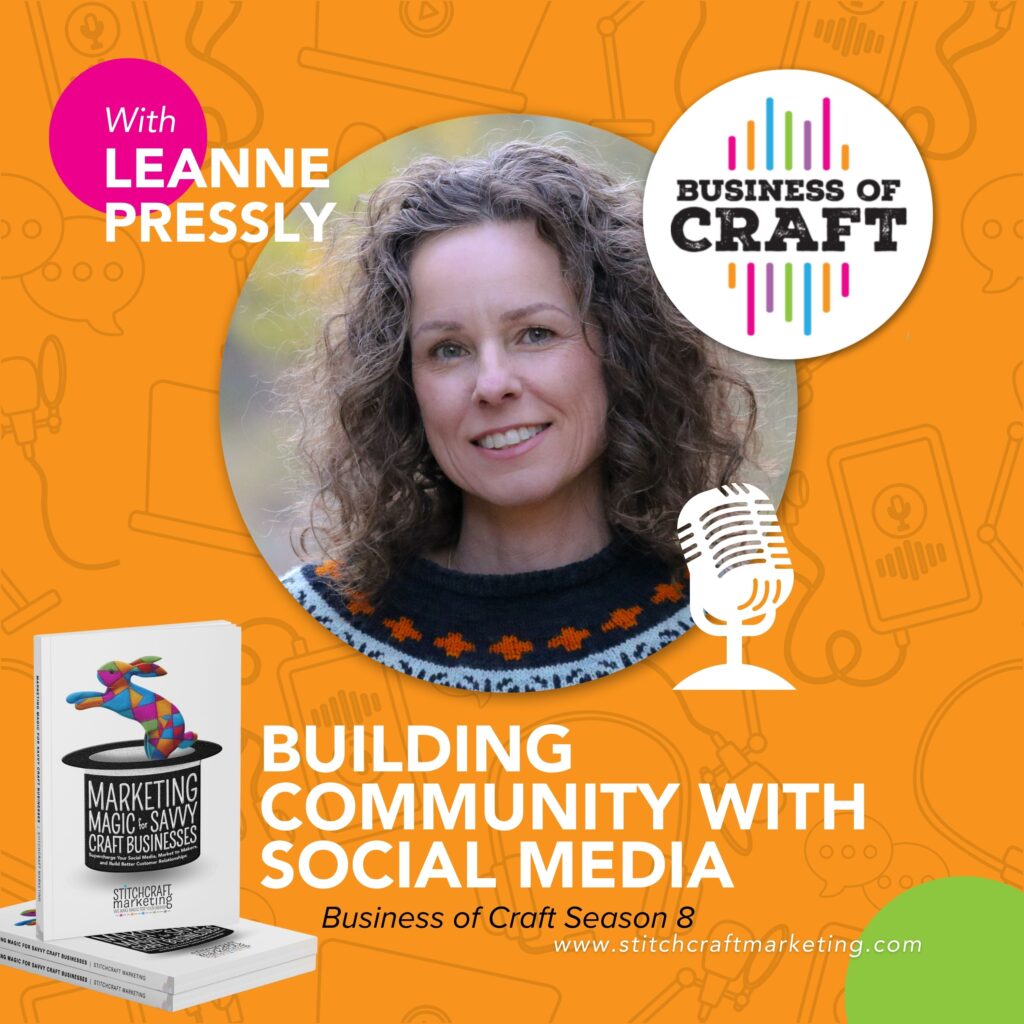WELCOME TO SEASON 8 OF BUSINESS OF CRAFT
Welcome to Business of Craft, a show designed to help entrepreneurs with fabric or fiber businesses become more successful.
This is our 8th season of BOC and today we have another solocast to cover one of the topics in our new book, Marketing Magic for Savvy Craft Businesses. I’m super proud of this book which my whole team wrote in 2025. The book is available for sale in Kindle and print version (and soon to be audio) on our website or Amazon.
Listen to the Show:
Listen to it on Spotify, iHeartRadio, iTunes, and PlayerFM, or catch the video version on YouTube.
Thank you for taking the time to listen! If you’re enjoying the show, it’s safe to assume there are others out there like you who would also enjoy the show. Help them find it by leaving a review on your favorite podcast platform. Don’t forget to subscribe to stay on top of the latest episodes!
Today we’re jumping into the topic of utilizing social media to build your community.
Let’s face it—scrolling is now a lifestyle.
Wake up: scroll.
Wait in line: scroll.
Go to bed: scroll.
The average person spends over 2 hours and 23 minutes a day on social media. That’s a massive opportunity for your craft business and create a mini community where you can showcase your brand.
And here’s the data to back it up: Many of you know we did an industry wide survey in 2023 and asked over 900 craft retailers their experiences on a variety of subjects. From that survey, we know:
- 61% of businesses engaged in social selling report revenue growth.
- 41% of craft retailers from our survey said social media is a top tool for generating sales.
So, this is a tool you cannot ignore….
At the same time, we’re definitely seeing a shift at the agency with clients where algorithms are not performing like they used to and engagement is so much harder to achieve. Mastering social media isn’t just about selling—it’s about community, visibility, and connection.
One of the things I teach about in my lesson on the know like trust funnel is that you’re really selling hope.
Think about it though, your customers and everyone really- is starving for a sense of belonging…. so you should think of your social channels as a method for growing and nurturing that place, that community where your customers feel seen and heard and have a sense of belonging.
Before you start posting, you need a plan. You wouldn’t start sewing a quilt or a crocheting a sweater without a pattern—so don’t start your content without a strategy.
Here are some essentials:
- Your mission: What value does your content provide?
- SMART goals: Track impressions, clicks, and engagement through the lens of Know, Like, and Trust.
- Your customer avatar: Who are you speaking to?
- Platform tactics: What content works best where?
- Brand guidelines: Consistency in tone, visuals, and voice is key.
- Content pillars: Think education, entertainment, promotion, and community.
- Engagement strategy: How often will you check messages? How will you respond?
- Ad spend: Outline your paid content strategy if you have one
- Community building: We’ll talk more about this in a minute.
If this sounds like a lot—it is. But the good news? Once you map it out, it’s rinse and repeat. And of course, if you’re feeling stuck, that’s what folks like the team at Stitchcraft Marketing are here for.
Not all platforms are created equal—and you don’t have to be everywhere. Remember that quality is more important than quantity so if you only have time for one or two channels, just focus on those and be sure to choose them in consideration of where your avatar is.
So let’s just do a brief overview of the channels we post on for our clients… and remember, the book has a lot more info about these individually.
📘 Facebook
Still king. With 3.06 billion monthly active users, it’s where many of your existing and potential customers hang out—especially if your target is women 45+. It’s great for community building, Facebook Lives, and live shopping events.
📸 Instagram
Owned by Meta, the same company that owns Facebook. Great for visual storytelling—product shots, Reels, tutorials, and connecting with younger makers. Generally speaking, IG skews slightly younger than FB…. You’re not going to find any 20 year olds on FB whereas IG you might. Easily cross-post with Facebook using a backend dashboard called Meta Business Suite.
📌 Pinterest
The unsung hero of craft retail. With 537 million monthly users, it’s a discovery search engine. 85% of weekly users go to Pinterest when starting a new project. Plus, it’s one of the top referral sources for website traffic. If you’re managing this channel correctly, you’ll see Pinterest in the top 5 rank of your referral sources. It’s VERY often overlooked but such a great platform for evergreen and long-tail value (meaning that it has staying power) When we audit client channels, so many of them are shocked to see that pins they put out YEARS ago are still bringing in traffic to their websites.
▶️ YouTube
No doubt that video performs and that’s where YouTube is a powerhouse. Great for tutorials, anything long format, behind-the-scenes etc.. SO Many of your customers are on YouTube. And don’t forget, like all these channels, its a search engine so don’t slack on your SEO—and naturally since it’s owned by Google, that functionality is stellar.
🎵 TikTok
Popular for younger craft enthusiasts. I want to say, however, that this algo is SUPER popular and if you sign on and start to watch content, that algo very quickly serves up content that you prefer…. so if you’re like me– a late 50’s female who wants to just see crafting videos and cute puppies–that’s what you’re going to get. So, don’t dismiss this channel as just being dancing teenagers…. Great for playful, behind-the-scenes or viral content—but you will need the time and energy to generate original videos on the app for frequent video posting.
We get asked a lot about specific community building tools so let’s talk about those as well.
👥 Facebook Groups
Create your own or participate in existing ones. They’re perfect for peer-to-peer interaction, project sharing, and feedback. I like that notifications from groups can take precedent and it works well to bring members back into your group. With good moderation, it can be more hands off for you too.
💬 Patreon
Create exclusive content for your superfans—tutorials, Zoom stitch sessions, behind-the-scenes videos, and more. Tiered pricing lets you monetize your biggest supporters.
🧶 Ravelry
Exclusively for the fiber community of knitters, crocheters and spinners, it’s Ideal for yarn shops, pattern designers, and knitting instructors. You can create your own group or join existing ones. I might add that advertising on Ravelry is ridiculously affordable so we love that platform.
Once you’ve chosen your platforms, it’s time to create content—but do it efficiently. Remember that being consistent is what will help you grow a community. Here are some tips we share with clients.
✅ Monthly content calendar – Block 30 minutes to plan topics and assets.
✅ Batch creation – Shoot and write all your content in one go.
✅ Reuse content across platforms – Resize as needed, but don’t reinvent the wheel.
✅ Templates – Save time and stay consistent.
✅ Use scheduling tools – We love Sprout Social and OnlySocial.
And don’t forget your Call To Action! Whether it’s “Click to shop,” “Comment below,” or “Tag a friend,” give your audience a reason to interact.
Before you post, remember that we’re building trust with our audience because we know that’s where sales conversions happen!
Go through a quick checklist of your best practices to make sure you’re building that trust such as:
- Is your branding consistent?
- Are your handles the same across platforms?
- Do your bios include keywords, links, and hashtags?
- Is your content organized into albums, highlights, or playlists?
- Have you told your audience where you prefer to connect with them? You don’t want direct messages sitting unanswered
Remember those SMART goals? Track them monthly.
Then quarterly, zoom out and ask:
- What content performs best?
- What’s flopping?
- Which channels are growing fastest?
We love tools like Klipfolio, Tableau, or even Excel templates for tracking this.
Social media changes fast. I think this is one of the reasons clients want us to manage their socials is because we’re always on top of best practices.
The best way to stay relevant? Subscribe to a few trusted newsletters, watch platform updates, and be an active user. Follow others in your industry. Observe what resonates. Test your own ideas. And give yourself permission to experiment.


